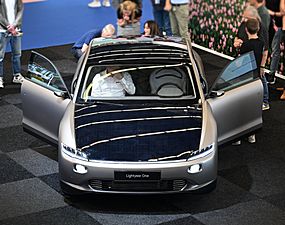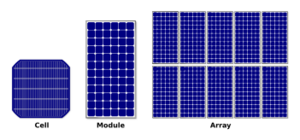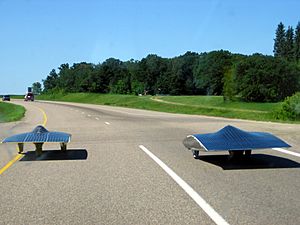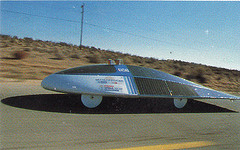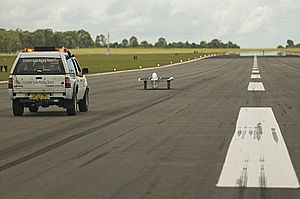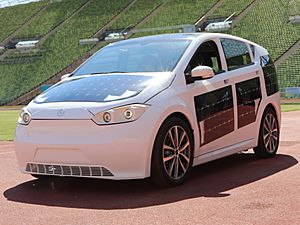Solar car facts for kids
A solar car is a special type of electric vehicle that uses power from the sun! These cars have solar cells built into them that turn sunlight into electricity. This electricity helps power the car, either fully or partly. Solar cars also usually have a rechargeable battery. This battery stores energy from the solar cells and from regenerative braking, which means the car recharges a little when it slows down. Some solar cars can even be plugged in to charge their batteries from other power sources.
Solar cars use cool technology from different areas like aerospace (think airplanes!), bicycles, and regular automotive (car) industries. When engineers design solar cars, they always focus on being super energy efficient. This is because they want to get the most out of the limited sunlight energy they can collect. Most solar cars are built for exciting races, but some companies are now making prototypes (test versions) for everyday use on roads.
There are many solar car competitions around the world. Teams from colleges and companies often join these races. The most famous race is the World Solar Challenge in Australia. Other big races include the American Solar Challenge and the United Solar Challenge.
As of late 2022, only one solar car, the Lightyear 0, had started being made for sale. However, the company stopped making and selling the car in early 2023. Another solar car, the Aptera, is expected to start being made in 2024.
Solar cars rely on a solar array. This is a big panel made of many photovoltaic cells (PV cells). These PV cells turn sunlight directly into electricity. When sunlight hits the cells, it makes tiny particles called electrons move, creating an electric current. PV cells are often made from materials like silicon.
Contents
History of Solar Cars
First Solar Car Models
The very first model solar car was a small 15-inch vehicle. It was created by William G. Cobb, who worked for General Motors. He showed off his invention, called the Sunmobile, in 1955 at a convention in Chicago. This tiny car used 12 special solar cells and a small electric motor.
In 1962, a company called International Rectifier added a solar panel to an old 1912 Baker Electric car. This was the first solar car that could actually carry passengers!
How Solar Cars Work
Solar Arrays: Catching Sunlight
The solar array on a solar car is made of hundreds of solar cells. These cells work together to turn sunlight into electricity. To build an array, many small PV cells are put together to form modules. Then, these modules are put together to form the large array. The biggest arrays can produce over 2 kilowatts of power.
Solar arrays can be placed on a car in different ways:
- Horizontal: This is the most common way. The array lies flat on top of the car. It gets the most power during the day, especially in sunny places. This design also doesn't catch much wind.
- Vertical: Sometimes, arrays are placed upright, like a sail. This can help catch wind energy too. But it only gets good solar power in the mornings, evenings, or winter, or when the car is facing the sun just right.
- Adjustable: Some solar arrays can tilt. This helps them get more power when the sun is low in the sky. The whole car might even tilt when it's parked to catch more sun.
- Integrated: Some cars have solar cells covering almost every part of their surface. While some cells might be at a perfect angle, others might be in the shade.
- Trailer: Some solar arrays are on a separate trailer that the car pulls. This is useful for adding solar power to cars that aren't very stable, like bicycles.
- Remote: Instead of being on the car, the solar array can be in a fixed spot, like a charging station. This can maximize power and make the car lighter. However, it means some energy is lost when sending power to the car.
Engineers choose the best way to mount the solar array by thinking about how much power it will make, how much wind resistance it will create, and how heavy it will be. For example, a flat, separate canopy can give 2-3 times more surface area than cells built into the car. It also helps cool the cells and shades the drivers.
Solar arrays on cars are attached differently from solar panels on houses. They are usually stuck right onto the car's body using strong tape. They are also covered with thin, protective layers. Some solar cars use special gallium arsenide solar cells, which are very efficient (around 30%). Others use silicon solar cells, which are about 20% efficient.
Batteries: Storing Energy
Solar cars have a battery pack that can store a lot of energy. A typical solar car battery can let the car travel about 400 kilometers (250 miles) even without any sun! It can also help the car keep going at speeds of 60 miles per hour (about 100 km/h) for a long time.
Motors: Making the Car Go
The motors in solar cars are usually not very powerful, often around 2 or 3 horsepower. But because solar cars are designed to be very light and efficient, these small motors can still make them go as fast as a regular family car, sometimes up to 100 miles per hour (about 160 km/h)!
Solar Car Races
Major Competitions
Two of the most famous solar car races are the World Solar Challenge and the American Solar Challenge. These are long-distance road races where university and company teams compete.
The World Solar Challenge is an international race where teams from all over the world try to cross the entire Australian continent. This race covers a distance of about 3,000 kilometers (1,860 miles). The cars have gotten faster and faster over the years!
The American Solar Challenge (also known as the 'North American Solar Challenge' before) features mostly college teams. They race in timed sections across the United States and Canada. This race has also changed its rules because teams were getting so fast they were reaching the speed limits! The most recent American Solar Challenge took place in 2018, going from Omaha, Nebraska, to Bend, Oregon.
The Dell-Winston School Solar Car Challenge is a yearly solar car race just for high school students. Teams from around the world, especially from American high schools, join this event. The race started in 1995. Every two years, the race changes its course. In some years, it's a road course starting in Texas, and in other years, it's a track race around the Texas Motor Speedway.
The South African Solar Challenge is a race that happens every two years. Teams race their solar cars across South Africa for two weeks. They have to build their own cars and design their own systems to handle the challenging terrain. This race has gained a lot of public interest and support from international groups.
Other distance races include events in Japan (like Suzuka and WGC) and the World Solar Rally in Taiwan.
Solar Car Speed Records
Fastest Solar Cars
The Guinness World Records keeps track of the fastest speed achieved by a vehicle powered only by solar panels. The current record is held by the Sky Ace TIGA from Ashiya University in Japan. It reached a speed of 91.332 kilometers per hour (56.75 mph) in 2014.
Before that, the record was held by the University of New South Wales with their car, Sunswift IV. They removed the car's battery so it was powered only by its solar panels. It set a record of 88.8 km/h (55.2 mph) in 2011. The record is measured over a 500-meter stretch, taking the average speed of two runs in opposite directions.
Solar Cars for Everyday Use
Prototypes and Production Models
The first solar family car was built in 2013. Researchers at Case Western Reserve University have also created a solar car that can recharge much faster.
A Chinese company called Hanergy plans to build and sell solar cars in China. They say that just five to six hours of sunlight could let their cars travel about 80 kilometers (50 miles) using only solar power. The car's total range could be around 350 kilometers (217 miles).
In 2019, the solar-electric car called Lightyear One (now known as Lightyear 0) was announced. It was designed by engineers who used to work for Tesla and Ferrari. The car's hood and roof are covered in solar panels. It can also charge like a regular electric car. In 2021, the company raised enough money to start making a limited number of these cars.
In 2019, Aptera Motors announced a plan to fund their solar-powered electric vehicle, the Aptera. They call it a "Never Charge" EV because it can get so much power from the sun. It's designed to have a very long range, up to 1,000 miles. The first prototype was shown in December 2020. As of 2023, they have built three versions of the prototype and are working on getting ready for production.
In 2020, the German car company Audi signed an agreement with an Israeli company called Apollo-Power. They plan to work together to put Apollo-Power's special lightweight, flexible solar panels into car parts. Apollo-Power's goal is to make every car in the world solar-powered!
In 2019, the Squad Solar City Car was announced by Squad Mobility. It was shown to the public in May 2022. This car is the first small solar car designed for city use.



